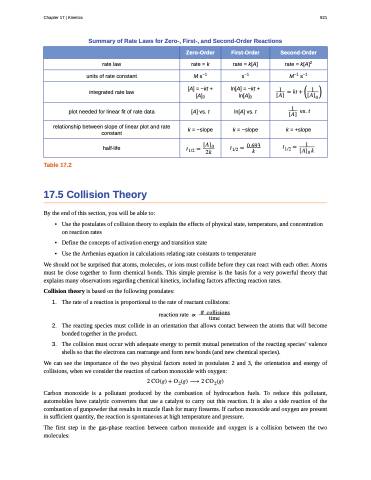Page 931 - Chemistry--atom first
P. 931
Chapter 17 | Kinetics
921
Summary of Rate Laws for Zero-, First-, and Second-Order Reactions
Zero-Order
First-Order
Second-Order
rate law
rate = k
rate = k[A]
rate = k[A]2
units of rate constant
M s−1
s−1
M−1 s−1
integrated rate law
[A] = −kt + [A]0
ln[A] = −kt + ln[A]0
� ��� ��� � �� � ������
plot needed for linear fit of rate data
[A] vs. t
ln[A] vs. t
� vs.t ���
relationship between slope of linear plot and rate constant
k = −slope
k = −slope
k = +slope
half-life
���� � ���� ��
���� � ����� �
���� � � �����
Table 17.2
17.5 Collision Theory
By the end of this section, you will be able to:
• Use the postulates of collision theory to explain the effects of physical state, temperature, and concentration on reaction rates
• Define the concepts of activation energy and transition state
• Use the Arrhenius equation in calculations relating rate constants to temperature
We should not be surprised that atoms, molecules, or ions must collide before they can react with each other. Atoms must be close together to form chemical bonds. This simple premise is the basis for a very powerful theory that explains many observations regarding chemical kinetics, including factors affecting reaction rates.
Collision theory is based on the following postulates:
1. The rate of a reaction is proportional to the rate of reactant collisions:
�������� ���� � � ���������� ����
2. The reacting species must collide in an orientation that allows contact between the atoms that will become bonded together in the product.
3. The collision must occur with adequate energy to permit mutual penetration of the reacting species’ valence shells so that the electrons can rearrange and form new bonds (and new chemical species).
We can see the importance of the two physical factors noted in postulates 2 and 3, the orientation and energy of collisions, when we consider the reaction of carbon monoxide with oxygen:
� ����� � ����� � � ������
Carbon monoxide is a pollutant produced by the combustion of hydrocarbon fuels. To reduce this pollutant, automobiles have catalytic converters that use a catalyst to carry out this reaction. It is also a side reaction of the combustion of gunpowder that results in muzzle flash for many firearms. If carbon monoxide and oxygen are present in sufficient quantity, the reaction is spontaneous at high temperature and pressure.
The first step in the gas-phase reaction between carbon monoxide and oxygen is a collision between the two molecules:


